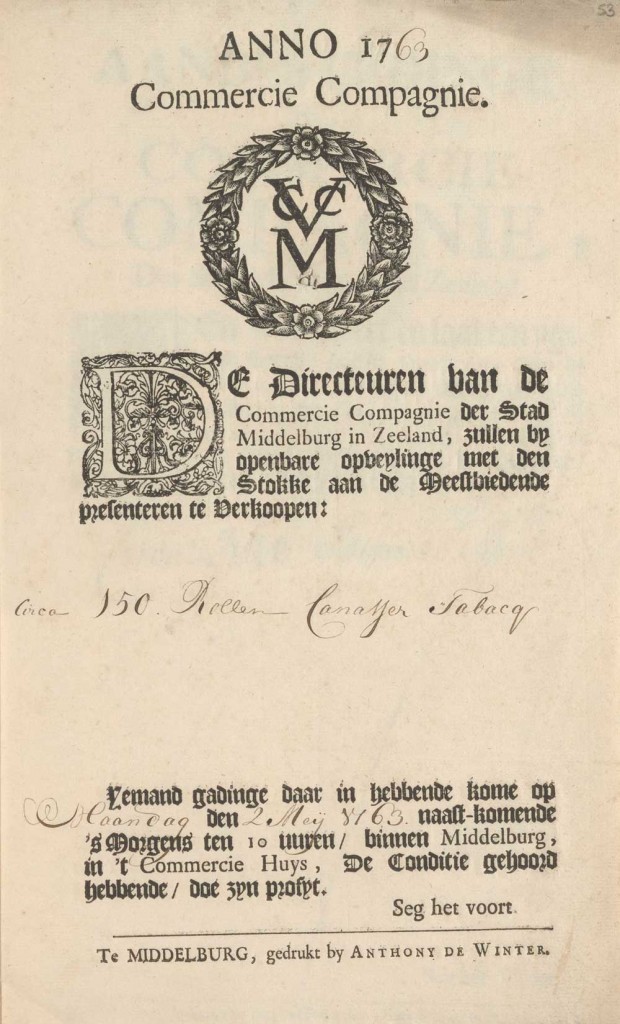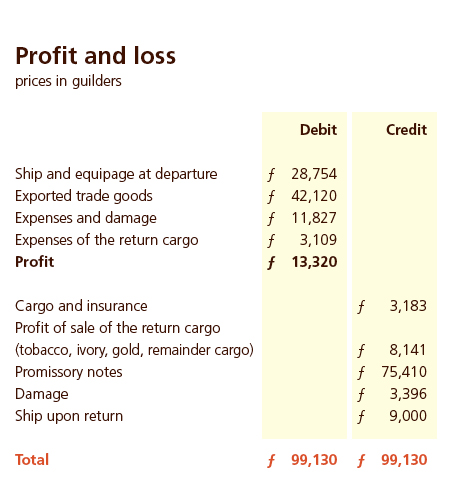On reaching the roadstead of Rammekens the sea voyage was officially completed, but the enterprise on the whole was far from finished. How did the sale of the return goods procede? Was the voyage profitable for the MCC? And what did the crew earn?
Unfortunately very little information is available in the archives on the fate of the enslaved Africans. Perhaps a few of them managed to flee in the uprising in Berbice. The majority of the enslaved people however, will have spent the rest of their lives in captivity, working as forced laborers on one of the many plantations in Guyana.
Return Goods
The return goods of The Unity were auctioned off on different days in Middelburg. On April 12th, 1763, the board of directors decided not to organize a separate auction for the goods of The Unity, the reason being that The Unity had brought back relatively small amounts of ivory and tobacco.
Instead, the directors decided that the ivory would be sold together with the return cargo goods of the ship the Petronella Cecilia, even though that ship was not owned by the MCC.
The tobacco was brought to an auction on May 2nd, 1763, which was organized by estate agent Adriaan van Dijk for some private shareholders in Middelburg.
The directors Lantsheer and Reijnders were apparently allowed first choice of tobacco. They bought five rolls, while the remaining 149 rolls were entered for auctioning by Van Dijk. He divided the 149 rolls into 32 different lots. According to the ship’s book, the tobacco was sold for a total of 284 Flemish pounds.
The tobacco had been wrapped in animal hides, which were sold as a single lot on May 5th for almost 7 Flemish pounds.
The ivory, consisting of larger and smaller elephant’s tusks and pieces of ivory was auctioned on June 2nd, in 6 different lots. The buyers paid a total of 862 Flemish pounds. The MCC directors were very satisfied with the profit, and in the next meeting the minutes note “that the sale had turned out extraordinarily well (according to quality), with good selling prices.”
Buyers of the Tobacco, Animal Hides and Ivory
- Jacobus Lantsheer, 1 roll of tobacco
- Salomon Reijnders, 4 rolls of tobacco
Sold by auction
- Benjamin Catteau, 3 lots of tobacco (18 rolls)
- Paulus H. Securius, 1 lot of tobacco (6 rolls) Christoffel Hentze, 3 lots of tobacco (18 rolls)
- Jan de Groot, 1 lot of tobacco (6 rolls)
- Roeland Pagter, 1 lot of tobacco (6 rolls)
- Ad. van Dijk, 5 lots of tobacco (30 rolls)
- Abraham Verheeke, 5 lots of tobacco (30 rolls)
- Jan Habens, 1 lot of tobacco (6 rolls)
- Abraham Mart., 2 lots of tobacco (11 rolls)
- Anth. Leliaart, 1 lot of tobacco (6 rolls)
- Johan Sanders, 1 lot of tobacco (7 rolls)
- Jacobus Aartsen, 1 lot of tobacco (5 rolls)
- Jan Kock, 1 lot of ‘hides’ (9 packs of animal hides)
- Wed. Maartens & Zoon, 2 lots of elephant tusks (44 pieces)
- Casp. Ribaut, 3 lots of elephant tusks (59 pieces)
- Boursje de Superville & Smith, 1 lot of elephant tusks (43 pieces)
Sugar
Contrary to the sales of tobacco and coffee, the third voyage of The Unity has left no archive documents of the sale of sugar. Neither does the ship’s book mention the sugar sales separately.
Profit or Loss?
The final accounts were drawn up at the end of December, 1763, and added to the ship’s book.
On the credit side the following were noted, in order:
- Profits from the transportation and insurance of plantation products
- Profits from the sale of the return cargo
- The payments in letters of exchange
- Payments of the insurance for the damages incurred in the Westerschelde
- The value of the ship after arrival
On the debet side the following were noted:
- The value of the ship on departure
- The purchase of the trade cargo
- The salary of the crew and a variety of expenses, such as the pilot’s compensation and any damage assessments
- Payments of the premiums for sold human beings to the officers, and the expenses incurred by the sales of the return cargo
- Profit
In total, the debet and credit together amounted to almost 16 522 Flemish pounds (£16521:12:5), roughly 99 130 guilders, or 975 395 euros (in 2013). The profit amounted to 2220 Flemish pounds, roughly 13 320 guilders, or 131 000 euros (in 2013).
Again therefore captain Jan Menkenveld had successfully run a profitable voyage for the MCC. He was perhaps the most successful slave trade captain in service of the MCC: of the seven voyages he led during his time with the MCC, six made a good profit.
Settling the Accounts
The accounts were drawn up before the end of the calendar year in which The Unity returned home. The company however, did not receive the moneys of the sales of enslaved Africans in Guyana until much later.
The first Africans were sold via auctions in Berbice, Guyana. Captain Jan Menkenveld authorized the auction master Abraham Wijs to act in his stead in receiving the payments. To that end, Wijs signed an obligation in which he personally vouched for the auction profits. Whether Wijs actually transferred the money remains unknown, although the archive documents of The Unity’s third voyage do mention that Abraham Wijs, after his return to Amsterdam, cut and ran – and that no one knew where he had gone.
The last Africans of The Unity were sold by auction in Essequibo, Guyana. The buyers were to pay in three installments, the first of which partly consisted of sugar. The rest could be paid in cash or through letters of exchange. The deferred payments were usually only satisfied years later, the last one in 1766.
Bonusses
The crew was paid in April 1763. The five highest-ranking crew members also received bonuses from slave sales and cash recognition payments. These consisted of respectively a percentage of the sales from enslaved Africans and a percentage of the profit of the voyage.
Slave Sales
The slave money was a percentage per slave sold in the Caribbean. During this voyage of The Unity, a total of 326 slaves were bought. Of these, 33 died and 293 were sold. Per sold slave the MCC returned f 7,20 ( €68,88 in 2014) to these crew members, giving a total of £ 351:12:0 (f 2109,60; €20.751,63 in 2014) for the 293 slaves sold.
The amount was divided according to rank. The captain received the largest percentage: per sold African he received 80 shillings. The first mate and master surgeon received 24 shillings each per sold slave. The second mate received 10 shillings, and the third mate 6 shillings.
Slave sales
- Captain Jan Minkenfeld – 80 shillings p.p.: £ 195:6:8
- First Mate Daniël Pruijmelaar – 24 shillings p.p.: £ 58:12:0
- Second Mate Johannes Schuts – 10 shillings p.p.: £ 24:8:4
- Third Mate Adriaan de Puit – 6 shillings p.p.: £ 14:13:0
- Master Surgeon Petrus Couperus – 24 shillings p.p.: £ 58:12:0
Recognition Payments
If the voyage proved profitable, the officers also received a percentage of the profit. To calculate that, the costs of the voyage, consisting of:
- The ship’s equipage
- The purchase of cargo goods
- The slave moneys paid to the crew
- Expenses incurred on return cargo
- Damages incurred on the homeward voyage
Were subtracted from:
- Payment of the slaves sold in Guyana
- Purchase value of the gold and tobacco
- Purchase value of the untraded African cargo
- Purchase value of the ivory
- The loan of the captain
Of that money: 1600 Flemish pounds (f 9600; or €208.162 in 2014) 12% was accorded to the crew as recognition payments, a total of 192 Flemish pounds (f 1152; or €24.979 in 2014). This money was also paid according to rank, and again the captain received over half of it.
The first recognition payments were paid in December 1763. After the second installment of letters of exchange had arrived, the second set of recognition payments were paid in February 1765. The final payments were made in November 1766, when the third batch of letters of exchange had arrived.
Recognition moneys, total
- Captain Jan Menkenveld – 5/9 of the total: £ 174:14:8
- First Mate Daniël Pruijmelaar – 1/6 of the total: £ 52:8:5
- Second Mate Johannes Schuts – 5/72 of the total:£ 21:16:9
- Third Mate Adriaan de Puit – 1/24 of the total: £ 13:1:1
- Master Surgeon Petrus Couperus – 1/6 of the total: £ 52:8:5
Over 3.5 years after the completion of The Unity’s third voyage the last bonusses were paid to the highest ranking crew members. Clearly, the captain made a lot of money: he was responsible for the ship, the cargo and the crew. Not just during the voyage but also before departure – the captain played an important role in deciding the composition of the cargo.
The bonusses of slave money and recognition money were considerable. Together they exceeded the captain’s salary, whereas the first mate earned about as much in bonusses as in salary.
Total income officers (salary, slave sales and recognition payments)
- Captain Jan Menkenveld: £ 594:12:2 (including a salary of £ 224:10:10)
- First Mate Daniël Pruijmelaar: £ 218:8:5 (including a salary of £ 107:8:0)
- Second Mate Johannes Schuts: £ 135:15:1 (including a salary of £ 89:10:0)
- Third Mate Adriaan de Puit: £ 99:7:1 (including a salary of £71:12:0)
- Master Surgeon Petrus Couperus: £ 245:10:5 (including a salary of £ 134:10:0. The Master Surgeon earned as much as the First Mate, but Couperus had yet to receive three months worth of pay, as can be seen from the ship’s payroll.)
The contrast with the lowest incomes is large. Sailor Johannis Coijwijk earned a salary of £ 47:14:8 (f 286,40; or €6201,49 in 2014). Apprentice Adriaan de Visser £ 32:16:4 (f 196,90; or €4249,97 in 2014). Ship’s boy Gilles Lint received the lowest income. He had earned £ 14:18:4 (f 89,5; or €1929,83 in 2014) with one-and-half-year’s of work. On the other hand, as described in the ship’s articles, the ship’s crew was permitted (to an extent) to trade for personal profit.
Hidden Revenues
All of the above does not constitute the full income of the highest-ranking crew members. The private trade conducted during the voyage remains invisible. Though these officers were forbidden from conducting trade for personal profit (see the instruction for the captain, nr 15), but this certainly occurred. In the end, it would be the cause of Menkenveld’s dismissal.




